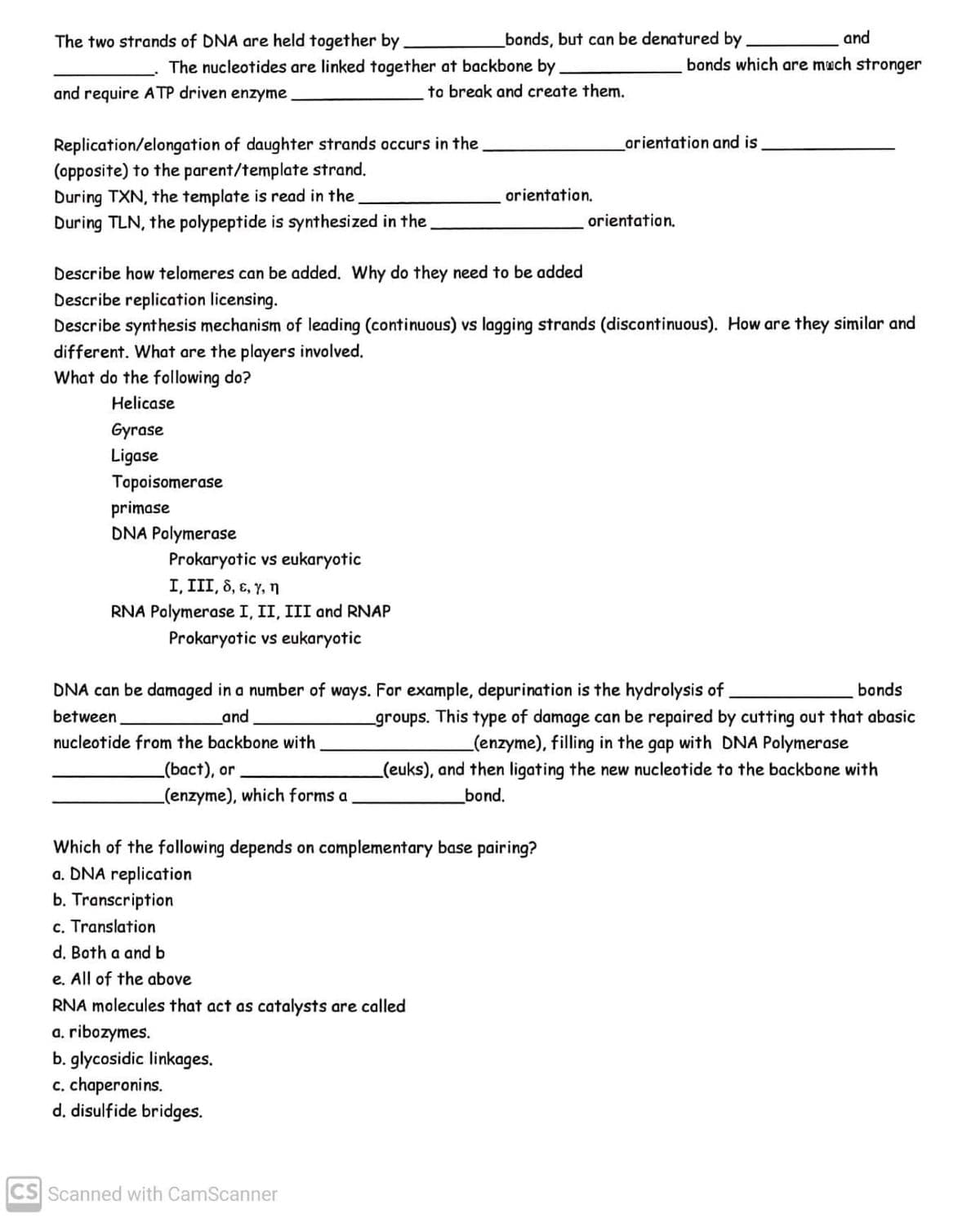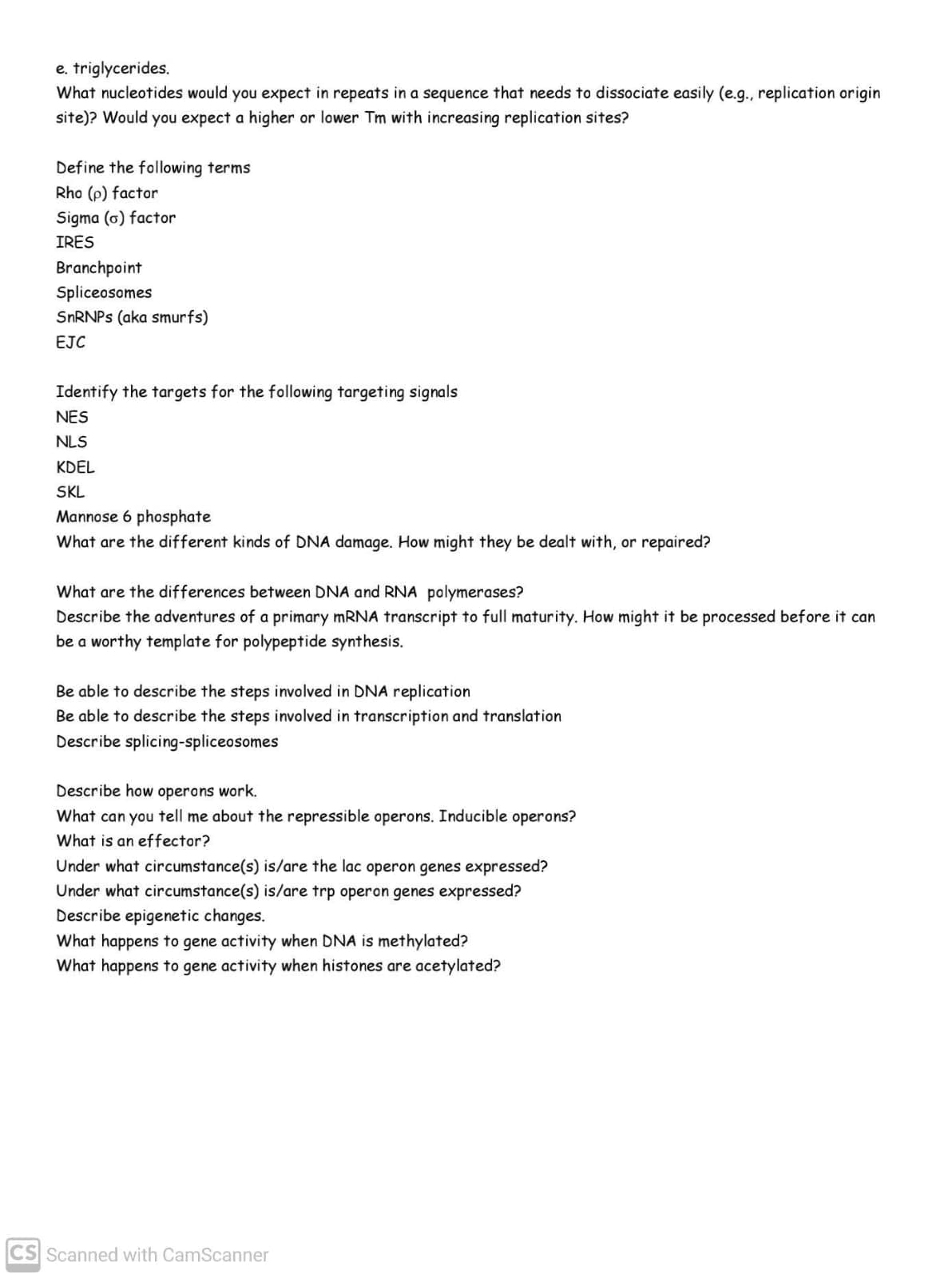The two strands of DNA are held together by. bonds, but can be denatured by and The nucleotides are linked together at backbone by bonds which are much stronger and require ATP driven enzyme to break and create them.
The two strands of DNA are held together by. bonds, but can be denatured by and The nucleotides are linked together at backbone by bonds which are much stronger and require ATP driven enzyme to break and create them.
Biology Today and Tomorrow without Physiology (MindTap Course List)
5th Edition
ISBN:9781305117396
Author:Cecie Starr, Christine Evers, Lisa Starr
Publisher:Cecie Starr, Christine Evers, Lisa Starr
Chapter6: Dna Structure And Function
Section: Chapter Questions
Problem 11SQ: Energy that drives the attachment of a nucleotide to the end of a growing strand of DNA comes from...
Related questions
Question
Type in response to each notes/questions

Transcribed Image Text:The two strands of DNA are held together by
bonds, but can be denatured by
and
The nucleotides are linked together at backbone by.
bonds which are much stronger
and require ATP driven enzyme
to break and create them.
Replication/elongation of daughter strands occurs in the
(opposite) to the parent/template strand.
During TXN, the template is read in the
During TLN, the polypeptide is synthesized in the
orientation and is
orientation.
orientation.
Describe how telomeres can be added. Why do they need to be added
Describe replication licensing.
Describe synthesis mechanism of leading (continuous) vs lagging strands (discontinuous). How are they similar and
different. What are the players involved.
What do the following do?
Helicase
Gyrase
Ligase
Topoisomerase
primase
DNA Polymerase
Prokaryotic vs eukaryotic
I, III, 8, ɛ, Y, n
RNA Polymerase I, II, III and RNAP
Prokaryotic vs eukaryotic
DNA can be damaged in a number of ways. For example, depurination is the hydrolysis of
bonds
groups. This type of damage can be repaired by cutting out that abasic
(enzyme), filling in the gap with DNA Polymerase
(euks), and then ligating the new nucleotide to the backbone with
between
and
nucleotide from the backbone with
_(bact), or
(enzyme), which forms a
bond.
Which of the following depends on complementary base pairing?
a. DNA replication
b. Transcription
c. Translation
d. Both a and b
e. All of the above
RNA molecules that act as catalysts are called
a. ribozymes.
b. glycosidic linkages.
c. chaperonins.
d. disulfide bridges.
CS Scanned with CamScanner

Transcribed Image Text:e. triglycerides.
What nucleotides would you expect in repeats in a sequence that needs to dissociate easily (e.g., replication origin
site)? Would you expect a higher or lower Tm with increasing replication sites?
Define the following terms
Rho (p) factor
Sigma (6) factor
IRES
Branchpoint
Spliceosomes
SNRNPS (aka smurfs)
EJC
Identify the targets for the following targeting signals
NES
NLS
KDEL
SKL
Mannose 6 phosphate
What are the different kinds of DNA damage. How might they be dealt with, or repaired?
What are the differences between DNA and RNA polymerases?
Describe the adventures of a primary mRNA transcript to full maturity. How might it be processed before it can
be a worthy template for polypeptide synthesis.
Be able to describe the steps involved in DNA replication
Be able to describe the steps involved in transcription and translation
Describe splicing-spliceosomes
Describe how operons work.
What can you tell me about the repressible operons. Inducible operons?
What is an effector?
Under what circumstance(s) is/are the lac operon genes expressed?
Under what circumstance(s) is/are trp operon genes expressed?
Describe epigenetic changes.
What happens to gene activity when DNA is methylated?
What happens to gene activity when histones are acetylated?
CS Scanned with CamScanner
Expert Solution
This question has been solved!
Explore an expertly crafted, step-by-step solution for a thorough understanding of key concepts.
This is a popular solution!
Trending now
This is a popular solution!
Step by step
Solved in 2 steps with 1 images

Knowledge Booster
Learn more about
Need a deep-dive on the concept behind this application? Look no further. Learn more about this topic, biology and related others by exploring similar questions and additional content below.Recommended textbooks for you

Biology Today and Tomorrow without Physiology (Mi…
Biology
ISBN:
9781305117396
Author:
Cecie Starr, Christine Evers, Lisa Starr
Publisher:
Cengage Learning

Biology Today and Tomorrow without Physiology (Mi…
Biology
ISBN:
9781305117396
Author:
Cecie Starr, Christine Evers, Lisa Starr
Publisher:
Cengage Learning